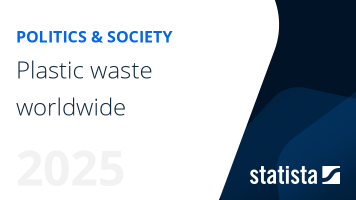Plastic waste worldwide - statistics & facts
The size of the plastic problem
Over the course of the past half a century, plastic products have become ubiquitous in daily life, a result of their versatility and varied applications. In 2023, global plastics production amounted to roughly 415 million metric tons, doubling in comparison to the beginning of the century. While the lifespan of plastic products can vary significantly, the use of short-lived applications such as packaging has grown significantly. By 2040, packaging is forecast to account for roughly 40 percent of plastic waste generation worldwide, the highest share of any application.How is plastic waste managed?
Despite a lot of effort put into boosting the collection and circularity of plastic products at the end of their lifecycle, recycling still represents less than 10 percent of plastic waste management worldwide. While a business-as-usual scenario would nearly triple the volume of plastic waste recycled by 2040, that would only translate to a share of 14 percent of plastic waste generated that year. Meanwhile, landfilling is expected to continue being by far the leading plastic waste management method globally, with over 300 metric tons disposed every year. In addition, over 100 million metric tons of plastic waste would still be mismanaged annually.The impacts of plastic waste pollution
Plastic waste can be found polluting the tallest mountains to the deepest ocean trenches and has even been found in drinking water and human blood. It is estimated that some 20 million metric tons of plastic waste leaked into the environment in 2020, with this figure expected to grow by 2040 without ambitious waste reduction policies. As a result, over 300 million metric tons of mismanaged plastic waste could accumulate in the world’s rivers and oceans by that year, destroying ecosystems, and harming wildlife.Enhancing recycling and closing leakage pathways are considered the two main strategies to reduce plastic leakage worldwide. Meanwhile, curbing plastics production and demand, one of the most contentious topics during the global plastic treaty negotiations, could yield a 10 percent reduction in plastic pollution by 2040, in compared to a business-as-usual scenario.







































